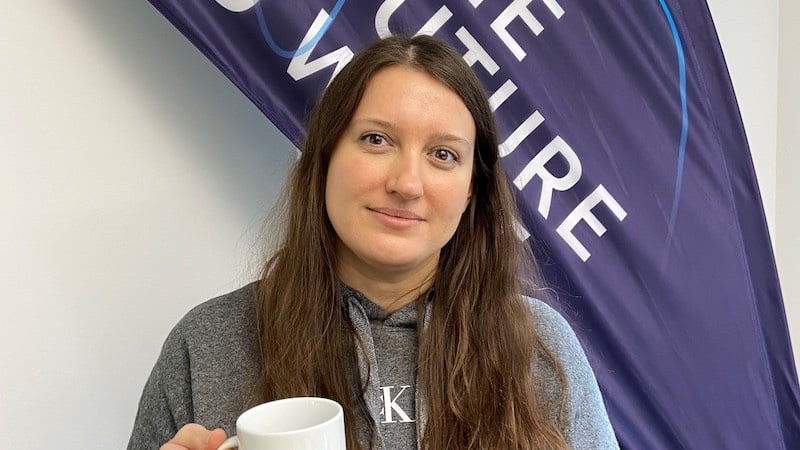
Digitization is changing our working world from the ground up. This is why new job descriptions are emerging. But what is hidden behind the designations? We want to make that tangible in “And what are you doing?” Today: Malgorzata Ilczyk, cloud architect at Capgemini.
BASIC thinking: Hi Malgorzata, you work as a cloud architect at Capgemini. Describe to us in four sentences how you explain your job to new friends.
As a cloud architect, I help customers to transfer classic IT systems into a new and modern world. I also like to compare my work to that of building a house: the new house has to be planned, built and made ready for occupancy before you leave the rented apartment.
We use the flexibility and the latest technology that the cloud offers to drive innovation in a company. An intelligent cloud architecture is characterized above all by a high degree of automation and massive scaling effects and is a key issue for companies striving for digital transformation.
The start of the day as a cloud architect
What does a normal day look like in your job?
As a cloud architect, I take on different roles over the course of a project. Therefore, depending on the project phase, there are also different to-do’s on my list. Sometimes these take place at the customer’s site, sometimes even abroad, but also in the comfort of one’s home or on the go.
This usually involves the preparation of offers, requirement analyzes through to the technical solution design and the full implementation and operationalization of a data platform. I am currently working on an international project in which, among other things, I have to be present at different locations.
A nice side effect: I can visit many exciting places. At the beginning of each project, I first discuss the customer’s vision and what requirements and tasks the desired data platform should fulfil.
We then assemble the team needed for the technical design and implementation of the project. In my current project, I lead a team of around 60 people working across different countries.
What do you start the day with?
I usually start in the classic way with a cup of coffee or in summer with a crisp three-kilometer run along the Elbe. Then at 9:00 a.m. I exchange ideas with my team for half an hour on the morning daily call. We discuss the current status of the project and plan the day.
We usually end the working day together with a battle call. We call the evening round Battle-Call because we rocked the day together. Since we also get along very well privately, we not only talk about ongoing projects in our evening calls, but also exchange ideas about topics outside of work.
The tasks of a cloud architect
What tasks are in your area?
As a cloud architect, the focus is not on a specific product but on the customer as a whole. The tasks are designed accordingly and you need a holistic view of the topics and backgrounds in order to develop innovative solution ideas.
I ask myself the following questions every day when developing solutions: How should the user experience on the platform
be designed? How should the data be provided and consumed? What parts of the solution do we automate to develop faster? In addition to the design and the operational implementation, as a manager, team leadership and project management are also part of my area of responsibility.
How do you personally define and interpret your job as a cloud architect?
To a certain extent, I see myself as a shaper of the future, since I bring state-of-the-art technology into companies, so that they in turn take a big step forward in their transformation processes.
Cloud computing takes our customers’ work to a new level, as certain processes reach a higher speed and certain costs and restrictions that exist with a classic IT architecture are eliminated.
I also know that the career options with my professional profile are very exciting and diverse. Personally, I have specialized in Azure data architecture and have thus established myself as an expert in this technology.
Integration into the corporate structure
How is your position integrated into the company structure? Say: Who do you report to and with whom do you work?
The hierarchies at Capgemini are flat, we all exchange ideas at eye level. I like to say that our projects are implemented in a good ecosystem in which we are closely networked within Capgemini in different areas and countries, but are also in constant contact with our customers and external service providers.
Of course, the role of the cloud architect is interpreted differently in every company.
What perspectives are you missing out on that are fundamentally part of the job profile?
At Capgemini we work on a large number of innovative projects and support large customers from a wide variety of industries, for example from the automotive, healthcare and public sectors. For me, this means that I can gain a wide range of experience and develop further.
What I always have to think about in my work: I’m not completely free in what I develop. Our customers decide on the implementation and the direction of the project. So I know the possibilities, but also the challenge of meeting the customer’s requirements.
That in turn is what makes my job so appealing: thinking about how the pieces of the puzzle between cloud architecture and customer requirements interact.
Fun and gratitude at work
What do you enjoy most about your job?
Solving customer challenges related to business intelligence and advanced analytics together in a team and helping to shape the future is incredibly motivating and also makes me proud. In addition, I really enjoy the fact that I am always learning new things and that Capgemini gives me the opportunity to further my education.
I am always deepening my knowledge, especially in the cloud environment, and have already acquired various certifications, among others. those to the Azure Data Scientist. I also started the Insights & Data Architects Community together with a colleague to give our data architects a way to stay in touch.
Since our world is turning very quickly, both in terms of customer requirements and from the technical side, we are dependent on regular exchange with each other. For this reason, we network our colleagues with one another via regular calls and a newsletter.
We also support our colleagues – with coaching and mentorships – in achieving internal and external training and architecture certifications (e.g. TOGAF9, IAF).
What are you particularly grateful for?
I really appreciate that at Capgemini I have the freedom to shape my own career path and also receive a lot of support. Various mentors – also at Vice President level, for example – have pushed me forward in the topics that interest me and have coached me intensively in order to set up my career plan in the best possible way.
We can also get involved in social projects with our own ideas, for example through our internal “Architects of Positive Futures” program. Great initiatives have emerged from this, such as FARM (Financial and Agricultural Recommendation Models).
Here we are developing an intelligent data platform to combat the global food shortage.
How does one actually become a cloud architect?
In the digital industry, there is often no longer the classic training. How did you get your position?
I first completed a bachelor’s degree in business informatics in Poland and then did a master’s degree in international management with a focus on business informatics in Germany.
I then applied to Capgemini because I was already familiar with the company as a global player in the IT industry and I found the professional opportunities exciting. The application process was very quick and uncomplicated. I was really impressed by this approach and the high level of appreciation, so I chose Capgemini.
What tip would you give to newcomers or interested career changers who also want to become a cloud architect?
Cloud architects need certain prior knowledge of the data environment. Anyone who wants to develop in the direction of data usually starts as a data engineer or developer. The most important skills are consolidated “on the job” in the projects. Anyone who has studied computer science already has most of the necessary prerequisites.
First practical experience is also advantageous. But most important are enthusiasm for data and willingness to learn. After all, we need the most comprehensive possible understanding of solutions and processes. There are many free training courses online with the focus on cloud architecture, you should also take this opportunity.
Ultimately, it is also possible without studying computer science, as long as the motivation is there to continue your education. For example, we also have archaeologists who are now working as cloud architects. So anything is possible.
Thank you Malgorzata!
Also interesting:
Source: https://www.basicthinking.de/blog/2022/10/04/digitale-berufe-cloud-architektin/


